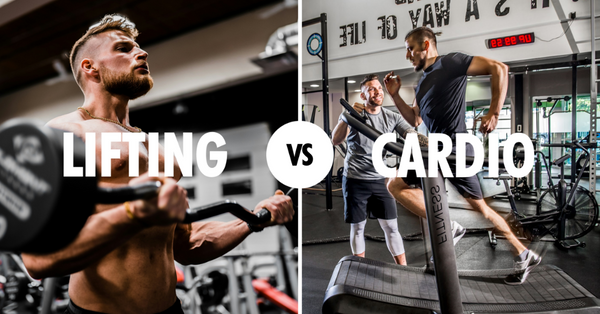How to Build Legs When Gym's Busy AF

We’ve all been there: You walk into the gym, pumped for leg day, only to find the squat racks all taken. You pivot to the leg presses, but they’re swamped too. It’s peak hours, and you know you’re in for a long wait. But instead of wasting time or compromising your workout, there's an effective and simple alternative — the goblet squat.
What is a Goblet Squat?
The goblet squat is a highly effective lower-body exercise that only requires a heavy dumbbell or kettlebell and a bit of space.
Holding the weight close to your chest, you perform a deep squat, engaging your quads, glutes, hamstrings, and core.

This movement not only builds strength but also improves mobility and stability. Plus, it’s perfect for crowded gyms because all you need is a little bit of floor space and a single dumbbell — no waiting for machines or racks.
Why Choose Goblet Squats Over Other Alternatives?
While machines like the leg press or barbell back squat are great for building muscle mass, the goblet squat offers unique advantages:
- Accessibility: No rack or machine required.
- Safety: Holding the weight in front of your chest allows you to maintain an upright posture, reducing the risk of lower back strain.
- The spine and neck are spared the stress of putting a barbell on your back.
- You can “bail out” easily if the weight gets too heavy by simply dropping/dumping the dumbbell forward, so (after a warmup set) go heavier than you think possible -- no spotter required.
- Core Engagement: The goblet squat naturally engages your core muscles as you stabilize the weight, giving you a more comprehensive workout.
- Improved Mobility: Squatting deep with proper form improves hip and ankle mobility over time.
How to Perform a Goblet Squat
1. Choose Your Weight: Pick a heavy dumbbell or kettlebell. Start with a moderate weight to perfect your form, then gradually increase as you gain confidence. Warm up with bodyweight, then test drive a set with a 40 or 50-pound dumbbell. If it’s all greenlights, the sky’s the limit. Ok, the limit is really what you can heave up into the starting position, but 70-120 pounds is a good working range. When you max out on what you can get into position, simply start adding reps (15-20 rep sets, etc.) to increase the difficulty.
2. Hold the Weight: Hold the dumbbell vertically, with both hands cupping the top end (ie, palms up as in the images), or grip the handle of a kettlebell. Keep the weight close to your chest.
3. Feet Positioning: Stand with your feet about shoulder-width apart, toes slightly pointed out.
4. Engage Your Core: Brace your core and keep your chest up.
5. Descend: Slowly lower your body by pushing your hips back and bending your knees. Aim to squat as deep as possible while maintaining good form. The mechanics of the goblet squat are really close to ideal, so many find they can squat much deeper, comfortably, than they would normally barbell squat or leg press.
6. Drive Back Up: Push through your heels and extend your legs to return to the starting position.
Pro Tip: Elevate Your Heels for Quad Dominance
If you're looking to target your quads more directly, try placing your heels on a 45-pound plate.

Programming Goblet Squats into Your Routine
When substituting goblet squats for barbell squats or leg presses, consider the following:
- Higher Reps, Lower Rest: Since goblet squats typically involve lighter weight compared to barbell squats, aim for 12-15 reps per set with minimal rest between sets.
- Superset for Intensity: Pair goblet squats with lunges or Romanian deadlifts for a killer leg pump.
- Progressive Overload: Gradually increase the weight or reps over time to keep challenging your muscles.
Additional Benefits of Goblet Squats
- Postural Improvement: Holding the weight in front forces you to maintain an upright torso, which helps improve posture.
- Joint-Friendly: The movement places less stress on the knees and lower back compared to traditional squats.
- Great for All Fitness Levels: Beginners can use lighter weights to build confidence, while advanced lifters can use heavier dumbbells for strength gains.
Final Thoughts
Next time you find yourself stuck in a crowded gym without access to a squat rack or leg press, don’t skip leg day. Grab a heavy dumbbell, find a little space, and master the goblet squat. With its safety, versatility, and effectiveness, you’ll not only maintain your sanity in a crowded gym, but you can build an impressive set of wheels too.
Also in News

Upper Chest Won't Grow? It's the Bench Angle.
Your upper chest is flat because your incline bench angle is sabotaging you. One simple adjustment changes everything.

Lifting vs Cardio for Fat Loss: What’s REALLY Better?
Which one’s truly best for cutting body fat? Here’s what the latest science has to say. 💪🔥

How Processed Foods Sabotage Gains (and Your Knees!)
New research shows junk food impacts muscle quality in ways nobody saw coming - with pictures *inside* the muscles to prove it. 👀 Trust, you need to see this...


